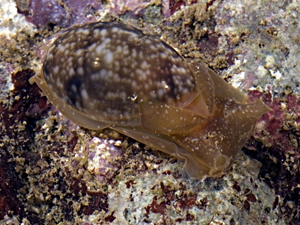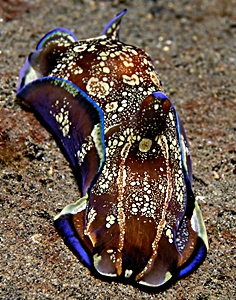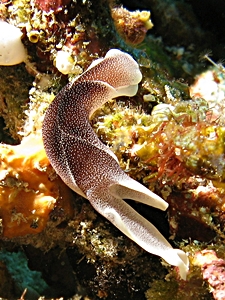
Bubble shell (Bulla ampliata) from the island of Moorea, French
Polynesia. Picture: Gustav Paulay (CalPhotos).
 Bubble shell (Bulla ampliata) from the island of Moorea, French Polynesia. Picture: Gustav Paulay (CalPhotos). |
Head shield snails are the most primordial opisthobranch snails. Of the about 7000 species, many still bear a shell, such as the bubble shells (Bullidae), even if it is strongly reduced and usually thin-walled.
 Philinopsis cyanea from the Timor Sea. View on the head. Picture: Nick Hobgood (Source). |
![]() Natural History
Museum Rotterdam:
Bullidae shell pictures.
Natural History
Museum Rotterdam:
Bullidae shell pictures.
The head shield, due to which those snails have their name, is a broadened part of the head, designed to dig in the soil and to protect the snail's mantle cavity from entering substrate.
Head shield snails hunt other opisthobranchs, sea-living polychaete worms and some species feed on foraminifers. Many species have well developed eyes and additional sense organs helping in the search for prey. The Hancock organ for example is a chemosensory organ located next to the right rhinophore. Sone species also have tentacles around their mouth to follow their prey's slime thread.
Among the head-shield snails there are also slugs, such as Philinopsis cyanea (Aglajidae family). In the Aglajidae family, apart from the Philinopsis genus, there are also for example the genera Chelidonura and Navanax. Their radula has been reduced, but that does not keep them from feeding on other gastropods, such as bubble shells, which are eaten completely with shell. The cephalaspidean extends the pharynx and at the same time sucks in the prey. The inedible shell later is later disgorged. This does, however, limit the slug in that it can only eat what is smaller than itself. On the other hand, Navanax inermis, a species living at the American west coast from California to Mexico, as well as in the Gulf of Mexico, grows to 22 cm size, being the largest species in the family.
The rear part of the head shield in those slugs is erect vertically as a crest. Also to be mentioned specially is the characteristic tail end of those slugs, which is forked to resemble a swallow tail, which is why those slugs are also referred to as swallow tail slugs. The parapodia are folded together over the back, as long as the slug is not swimming.
 A view on the tail end of Chelidonura amoena ("Starry swallow tail slug"). Picture: Silke Baron (Source). |
Though they are often referred to as "nudibranchs" in English, swallow tail slugs by no means are nudibranchs. Those, however, are among their favourite prey, as do juvenile sea hares. Swallow tail slugs do make a distinct difference between nudibranchs feeding on other gastropods, which they love to eat, and nudibranchs feeding on jellyfish, which they avoid: Here the advantage of acquiring nettle cells is quite obvious.
Small tentacles under the head shield (often invisible from above), as well as further mouth tentacles or sensory bristles help the slug in following its prey's scent. Examinations, however, have yielded the result that the slug obviously cannot discern, which way the prey has crawled, which is why it may happen that the slug follows the scent in the wrong direction, to the prey's advantage.
|
An almost romantic dive ends in an tragedy, when a nudibranch (Hermis-senda crassicornis) meets its fate in a cephalaspidean slug (Navanax in-ermis). Poetic justice (Author's remark), because Hermissenda crassicor-nis also feeds on smaller nudibranchs. Source: YouTube. |
|
|
Mike Roberts: Philinopsis cyanea hunting Stylocheilus. On seaslugforum.net. Stylocheilus is a sea hare. | |
|
|
Mary-Jane Adams: Chelidonura inornata - Mating and Trail Following. On seaslugforum.net. |
Some primordial properties of head-shield snails indicate a close relationship with Streptoneura (cross nerve snails, meaning prosobranchs): So the pleurovisceral connectives (see Snails' nervous system), the longitudinal nerves between pleural and visceral ganglia, are still crossed and detorsion not yet completed. The ganglia also are little concentrated.
One group, the Acteon genus, even still has a shell lid (Operculum), which generally is absent in opisthobranchs. The Acteonoidea superfamily, however, in the meantime has been excluded from the cephalaspidean group and (for want of a suitable higher group) has been placed in the lower Heterobranchia as an independent superfamily (see Systematics of Gastropoda: Lower Heterobranchia). In the North Sea (Iceland, British Isles, Norway), in the Atlantis (as far as the Congo) and in the Mediterranean, there is, for example the lathe acteon (Acteon tornatilis). In the Acteonoidea there is also the red-striped bubble shell, Bullina lineata (Bullinidae, not to be confounded with Bullidae, see above) from Australia.
![]() Judith Oakley: Acteon
tornatilis trails on seaslugforum.net.
Judith Oakley: Acteon
tornatilis trails on seaslugforum.net.